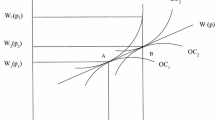Abstract
The theory of compensating wage differentials is generally accepted. It states that firms have to pay wage bonuses for hazardous work. However, there is as yet no strong or even contrary evidence for compensating wage differentials in Germany. By estimating wage regressions with data from the German Socio-Economic Panel (GSOEP) and using individually perceived hazards of work accidents as a risk variable, evidence that firms do pay risk premiums for hazardous work are found even though other effects could dilute the existing wage bonuses. Taking into account these results, the incentives for German firms to invest in accident prevention are discussed in the context of the existing institutional conditions.
Similar content being viewed by others
References
Backes-Gellner, Uschi/Lazear, Edward P./Wolff, Birgitta (2001), Personalökonomik.
Bellmann, Lutz (1994), Entlohnung als Risikokompensation, in: Mitteilungen aus der Arbeitsmarkt- und Berufsforschung, 4, Jg., S. 351–358.
Borjas, George J. (1996), Labor Economics.
Dorman, Peter/Hagstrom, Paul (1998), Wage Compensation for Dangerous Work Revisited, in: Industrial and Labor Relations Review, Vol. 52, (1998), pp. 116–135.
Ehrenberg, Ronald G./Smith, Robert S. (1996), Modern Labor Economics.
Elliott, Robert F./Sandy, Robert (1998), Adam Smith May Have Been Right After All: A New Approach to the Analysis of Compensating Differentials, in: Economics Letters, Vol. 59, pp. 127–131.
Franz, Wolfgang (1996), Arbeitsökonomik.
Gerlach, Knut/Hübler, Olaf (1998), Firm Size and Wages in Germany — Trends and Impacts of Mobility, in: Empirica, Vol. 25, pp. 245–261.
Haisken-De New, John P./Schmidt, Christoph M. (1994), The Industrial Structure of German Earnings 1980–1990, in: Allgemeines Statistisches Archiv, 78, Jg., S. 141–159.
Halvorsen, Robert/Palmquist, Raymond (1980), The Interpretation of Dummy Variables in Semilogarithmic Equations, in: American Economic Review, Vol. 70, pp. 474–475.
Hamermesh, Daniel S. (1978), Economic Aspects of Job Satisfaction, in: Ashenfelter, O./Oates, W. (Eds.), Essays in Labor Market Analysis, pp. 53–72.
Hwang, Hae S./Reed, W. Robert/Hubbard, Carlton (1990), Compensating Wage Differentials and Unobserved Productivity, in: Journal of Political Economy, Vol. 100, pp. 835–858.
Kötz, Hein/Schäfer, Hans-Bernd (1993), Economic Incentives to accident prevention: An Empirical Study of the German Sugar Industry, in: International Review of Law and Economics, Vol. 13, pp. 19–33.
Kunreuther, H. et al. (1978), Disaster Insurance Protection, Public Policy Lessons.
Lalive, Rafael (2000), Did we Overestimate the Value of Health? Institute for Empirical Research in Economics. University of Zurich. Working Paper No. 60.
Lazear, Edward P. (1998), Personnel Economics for Managers.
Lorenz, Wilhelm/Wagner, Joachim (1988a), Gibt es kompensierende Lohndifferentiale?, in: Zeitschrift für Wirtschafts- und Sozialwissenschaften, 108. Jg., S. 371–381.
Lorenz, Wilhelm/Wagner, Joachim (1988b), Kompensierende Lohndifferentiale, in: Wirtschaftswissenschaftliches Studium, S. 515–518.
Lorenz, Wilhelm/Wagner, Joachim (1989), Kompensierende Lohndifferentiale und geschlechtsspezifische Einkommensdiskriminierung, in: Gerlach, Knut/Hübler, Olaf (Hrsg.), Effizienzlohntheorie, Individualeinkommen und Arbeitsplatzwechsel, S. 248–270.
Schauenberg, Bernd (1999), Risiko und Risikoregulierung von Beschäftigungsverhältnissen, in: Wagner, G. R. (Hrsg.), Unternehmensführung, Ethik und Umwelt — Hartmut Kreikebaum zum 65. Geburtstag. S. 424–453.
Schmidt, Christoph M./Zimmermann, Klaus F. (1989), Der implizite Markt für Arbeitsbedingungen, in: Jahrbuch für Sozialwissenschaft, 40. Jg., S. 187–201.
Schmidt, Christoph M./Zimmermann, Klaus F. (1991), Work Characteristics, Firm Size and Wages, in: The Review of Economics and Statistics, Vol. 73, pp. 705–710.
Smith, Adam (1976), An Inquiry into the Nature and Causes of the Wealth of Nations.
Viscusi, W. Kip (1993), The Value of Risks to Life and Health, in: Journal of Economic Literature, Vol. 31, pp. 1912–1946.
Author information
Authors and Affiliations
Corresponding author
Additional information
I am grateful for helpful comments from Robert Flanagan, Knut Gerlach, Matthias Kräkel, Edward Lazear, Andrea-Eva Smolka and two anonymous referees. This paper was completed during a stay at the Graduate School of Business at Stanford University, which was made possible by financial support of the DAAD.




